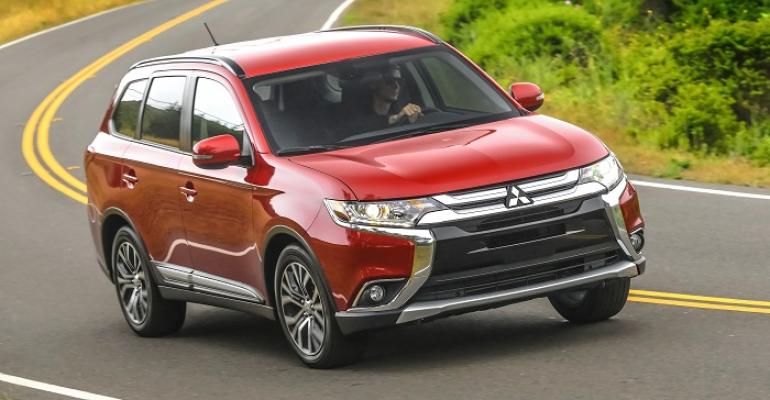SAN FRANCISCO – Mitsubishi has had a tough decade and looked about to follow Suzuki out of the U.S. market.
But lately the Japanese automaker has been on a hot streak in the States.
May’s 9,575 deliveries were up 36.8% from year-ago, and represented the brand’s 15th consecutive monthly increase.
With 41,581 new vehicles sold through May, up 23.6% from the same period year-ago, it seems 2015 could be the year Mitsubishi achieves a long-sought-after goal and returns to the 6-figure mark.
But Don Swearingen, executive vice president-Mitsubishi Motors North America, downplays the likelihood of that.
“I think it’s probably (going to happen) next year,” he tells WardsAuto in an interview here during a ’16 Outlander preview. “Our goals are internally set a little conservative, because I want to set the budgets throughout the company pretty conservative.”
As for getting back to the record 345,111 sales Mitsubishi tallied 13 years ago, Swearingen says the company isn’t aiming that high just yet.
The automaker is in the midst of a 5-year plan that targets Mitsubishi’s U.S. sales hitting 150,000 annually, but anything beyond that is not being discussed.
“I think it’s very easy to throw a big number out there…(but) we don’t want to be a flash in the pan and hurt ourselves long-term,” Swearingen says.
Mitsubishi entered the U.S. market in 1982 and brand sales topped 100,000 units annually by 1987 and 200,000 by 1994, WardsAuto data shows.
The automaker rode a hot streak to the record 345,111 deliveries in 2002.
But from 2003 to 2012 sales were on an almost-consistent downward trajectory, as Mitsubishi’s relationship with equity partner DaimlerChrysler dissolved and the brand in the U.S. was hurt by defaults from a 0% loan scheme in the early 2000s.
Annual U.S. sales volume in 2009, 2010 and 2012 fell into the 50,000-unit range, a level not seen since 1984.
But Mitsubishi sales grew in 2013 and 2014. Last year’s 77,643 units was the brand’s best tally since 2011’s 79,020.
Limit Fleet Sales, Protect Daily Rental
Swearingen vows MMNA will not achieve its volume goals via fleet sales, admitting the brand in the past five years got too reliant on sales to non-retail customers.
“We were as high as (a) 25% (fleet ratio), now we’re down around 7% and our goal internally is to keep it below 10%,” he says.
But whereas most automakers are trying to whittle down their fleet ratio by slashing sales to daily-rental firms, Mitsubishi is trying to maintain its rental-car volumes.
“When you go to a daily-fleet company you can sell thousands (of vehicles) at a time so you can make a commitment to the factory,” he says, referring to Mitsubishi’s vehicle-assembly plants. The automaker’s sole North American plant, in Normal, IL, has been operating below capacity for more than a decade.
Many automakers prefer to sell to more-prestigious corporate and government fleet clients, and while Mitsubishi does participate in this side of the business via a partnership with Penske, Swearingen says, “The volume is not huge.”
Whatever form Mitsubishi’s fleet participation takes, the EVP says it must be profitable. He cautions against “dumping cars into daily-rental fleets just to keep them moving, even (if you sell them at) a loss.
“We do not do that,” Swearingen says. “We’ve done it in the past, (but) it’s a wrong model in our opinion, and it hurts the residual value of the car, not only for lease purposes but for the owners who are trying to sell that car in a few years and get into another Mitsubishi.”
Fleet business remains a somewhat mysterious side of new-vehicle sales in the U.S.
Not all automakers disclose their fleet ratio, some do but not consistently, while others are an open book.
Mitsubishi’s Japanese rivals Toyota and Honda have fleet ratios below 10%, with the latter not selling to fleets at the corporate level but engaging in the practice via its dealers.
Domestic manufacturers FCA US, Ford and General Motors have some of the biggest fleet volumes in the industry. Ford says fleets accounted for 32% of the 245,626 light vehicles it sold in the U.S. in May.
A 7% fleet ratio means 670 of Mitsubishi’s 9,575 May deliveries were to non-retail customers.
This summer the brand is launching a heavily refreshed ’16 Outlander compact CUV, with more than 100 changes vs. the ’15 model.
Other new models expected include a sedan variant of the Mirage subcompact later this year and next year a plug-in hybrid version of the Outlander, as Mitsubishi continues to pursue a global electrification strategy.





